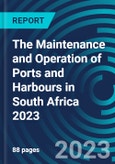Introduction
Transnet National Port Authority (TNPA), the sole landlord of South Africa’s commercial ports, and port terminal operator Transnet Port Terminals (TPT) posted a net profit in 2022. Yet South Africa’s ports are among the least efficient in the world and compare unfavourably to almost all ports on the African continent. Dry mineral bulk terminals’ cargo throughput has reduced significantly due to Transnet’s rail inefficiencies. The ports are characterised by ageing, unreliable and inadequately provided equipment and technology, yet they suffer from chronic capital underspend. Capital expenditure by TNPA has remained below budget for over a decade, causing the Ports Regulator to question its ability to undertake the necessary investments and causing stakeholders to question Transnet’s commitment to maintaining, upgrading and refurbishing ports. These stakeholders have accused Transnet of transferring profits from ports to cross-subsidise its other divisions. The pandemic, global shipping crisis, July 2021 unrest, a cyber-attack on Transnet, the Durban floods, strike action in October 2022 and the interrupted functioning of Transnet’s coal rail business have underscored the ports’ inefficiencies and need of capitalisation. Most stakeholders’ hopes are pinned on the planned corporatisation of TNPA to make the ports system more competitive and efficient.Opportunities
Development of a more environmentally friendly ‘green’ port system. Establishing South African ports as hubs for green fuels and as contributors to the decarbonising of maritime transport. Promotion of Ngqura as a regional transhipment hub. The development of infrastructure for liquefied natural gas-fuelled vessels. The development of smart port solutions, including the use of drones for onboard cargo deliveries. The expansion of the port system to include a new port at Boegoebaai in the Northern Cape and the new Durban dig-out port. The revitalisation of small harbours under the Operation Phakisa programme.Outlook
Recovery depends on budgeted capital being fully spent, something that has not been done for over a decade. Most commentators believe that the prospects of a turnaround in investment in ports will hinge on the planned corporatisation of the Transnet National Ports Authority. Corporatisation is expected to enable TNPA to become more efficient and productive as it operates along commercial lines and facilitate the introduction of more competition among terminal operations. Without the successful corporatisation of TNPA, stakeholders fear the inefficiency of the ports will persist and other African ports will become increasingly attractive for shipping lines as alternatives routes to African inland markets.Report Coverage
This report on the maintenance and operations of ports and harbours in South Africa includes comprehensive information on volumes handled, capacity, developments and performance against benchmarks. There are profiles of 14 companies including major players such as Transnet and Bidfreight, developments including the V & A Waterfront and Club Mykonos and maintenance companies including Yachtport and OSC Marine.Strengths
Multi-modal transportation systems connect South Africa’s main ports and terminals to extensive road and rail networks. Ports are essential for the import, export, and transhipment of goods. South Africa is a regional maritime trading hub. It is in a strategic position on major international maritime routes and is near to African offshore oil and gas fields. The government, through Operation Phakisa, has earmarked the sector for development and significant resources and investment have been allocated for port capacity expansion and refurbishment, skills development and training.Threats
Disruption from adverse weather events. Further weakening of the economy and funding constraints due to recessionary conditions. Industrial action. Maritime disasters, such as oil spills. South African ports are expected to face growing competition from other African countries where substantial investments in port infrastructure have been or are being made.Weaknesses
Access to berthing, mooring and launch facilities is limited. Capacity constraints are compounded by inadequate cargo handling equipment. Lack of port and harbour infrastructure maintenance. Port equipment is poorly maintained, resulting in frequent service outages and cargo handling delays. Service levels are generally poor, port tariffs are high, and processes are inefficient. South Africa’s state-owned ports system is monopolistic.Table of Contents
1. INTRODUCTION4. AFRICA5. INTERNATIONAL8. SWOT ANALYSIS9. OUTLOOK10. INDUSTRY ASSOCIATIONSAPPENDICESAPPENDIX - Location of Lighthouses in South AfricaAPPENDIX - Summary of Notable Players
2. DESCRIPTION OF THE INDUSTRY
3. LOCAL
6. INFLUENCING FACTORS
7. COMPETITIVE ENVIRONMENT
11. REFERENCES
COMPANY PROFILES
Companies Mentioned
- Bidfreight Port Operations (Pty) Ltd.
- Club Bayshore Marina (Pty) Ltd.
- Club Mykonos Langebaan (Pty) Ltd.
- Cps Projects (Pty) Ltd.
- Harbour Island Master Homeowners Association Npc
- Osc Marine Africa (Pty) Ltd.
- Port of Call Consulting Cc
- Port St Francis Property Owners Association Npc
- Portquip Africa (Pty) Ltd.
- Royal Alfred Marina Home Owners Association
- Southern Oceaneering (Pty) Ltd.
- Transnet Soc Ltd.
- V and a Waterfront Holdings (Pty) Ltd.
- Yachtport SA (Pty) Ltd
Methodology

LOADING...








